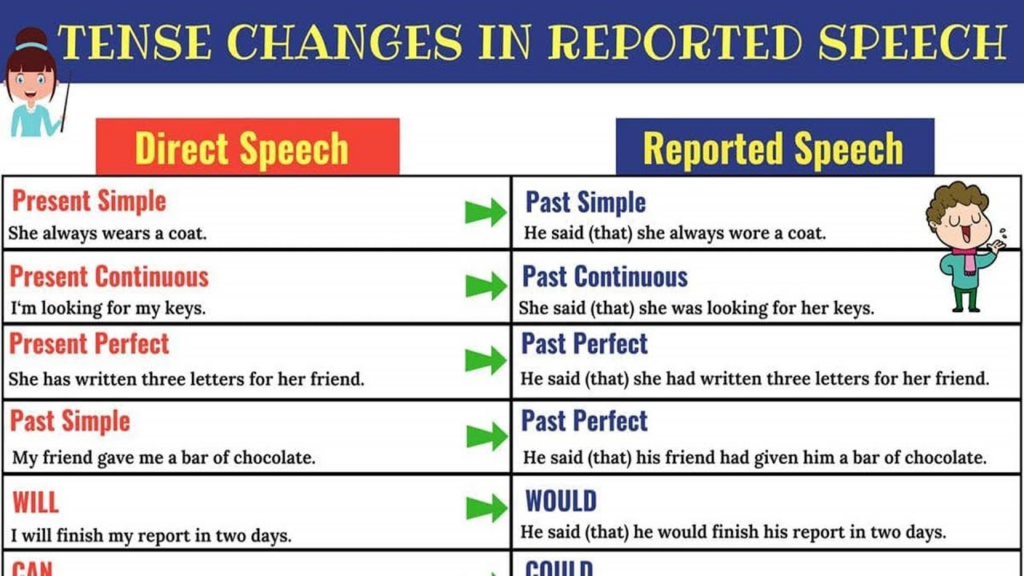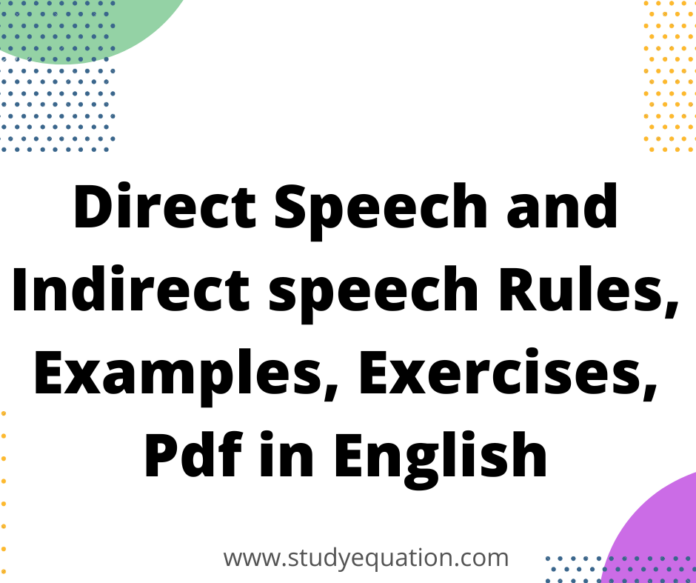In any instance when people are talking, they use Direct Speech and Indirect speech, it is the same way for written and verbal communication. It is used to describe what a person said in a direct or indirect way.
Table of Contents
Definitions of Direct and Indirect Speech with examples
Direct Speech: – A direct speech report details the precise words a speaker or writer used. The spoken words are enclosed in inverted commas and must be written or spoken word for word. The person who is speaking reports or conveys the message they want to deliver in their own words with any alterations. The general how we talk to each other through phone or face to face is in Direct speech.
Example: – “I am very busy today.”
“I am supposed to complete this task in a day.”
Indirect Speech: – Indirect speaking refers to when we summarise another person’s words using our own language. We do not write exactly what someone says or writes, and we don’t use inverted commas. The speaker conveys or reports what was said in the words of the person who originally said that. It is reported or Indirect speech when we tell someone what a third person said or when we tell what we talked to the third person.
Example: – Shivangi said that she was very busy then.
Om said that he was supposed to complete the task in the span of one day.

Direct Speech and Indirect speech Rules
Changing Direct speech to Indirect speech
There are several elements that go into converting a direct speech sentence into an indirect speech sentence, including reporting verbs, modals, time, place, pronouns, tenses, etc. We will go over each of these elements individually.
(1) 1st Rule – Reporting verbs
If the reporting verb of the direct speech is in past tense the all the present tenses are changed to the corresponding past tenses which changing the sentences to Indirect speech from direct speech.
Example: –
Direct: – She said, ‘I want the toy.’
Indirect: She said that she wanted the toy.
However, there are some situations where in the tense of the direct to indirect speech does not change. There are only few such situations.
i. If the reporting verb of the sentence is in present or in future tense then the tenses of the direct speech do not change.
Direct: She says, “I will be going to Delhi tomorrow.”
Indirect: She says that she will be going to Delhi tomorrow.
ii. If the words stated within the quotes talk about some universal truth or about any habitual action then in indirect speech the tenses do not change.
Direct: He said “Humans cannot live without water.”
Indirect: He said that humans cannot live without water.
(2) 2nd Rule – Interrogative Sentences
if a sentence in direct speech begins with a question (what/where/when) then no conjunction is used, as the “question-word” itself acts as a joining clause.
Points to note: Words such as ‘said/said to’ which are known as reporting verbs are changes to become asked, enquired or demanded.
Example:
Direct: “Where do you live?” asked Rohan.
Indirect: Rohan enquired where I lived.
Note: The joining clause is changed to if or whether, if a direct speech begins with an auxiliary verb/ helping verb.
Example:
Direct: He said, ‘Will you come to the water kingdom.’
Indirect: He asked whether I would come for the water kingdom.
(3) 3rd Rule- Present Tense, Past and Future Tense
List of the which tense changes to what is as follows:
i. Simple Present Changes to Simple Past
Example: She said “I am unwell,” changes to she said she was unwell.
ii. Present Perfect Changes to Past Perfect
Example: He said ‘She has finished her homework,” changes to he said that she had finished her homework.
iii. Present Continuous Changes to Past Continuous
Example: She explained “I am playing the Ukulele.”
Changed to she explained that she was playing the Ukulele.
iv. Past Continuous Changes to Past Perfect Continuous
Example: They told me “We were playing basketball”, changed to they told me that they has been playing basketball.
v. Simple Past Changes to Past Perfect
Example: He said, “Prerna arrived on Sunday”, changed to he said that Prerna had arrived on Sunday.
vi. Future Continuous Changes to Conditional Continuous
Example
Direct: She said “I will be giving my birthday party next Saturday.”
Indirect: She said that she would be giving her birthday party the following Saturday.
(4) 4th Rule- Modal changes
The modals used in the sentences also change while we are changing direct speech to indirect speech, some examples could be:
1. May becomes might
2. Must becomes had to/ would have to
3. Can becomes could
Examples:
D: She said, ‘I may buy shoes.’
Ind: She said that she might buy a dress.
D: He said, ‘He can climb a tree.’
Ind: He said that he could climb a tree.
However, there are some modals that do not change- like could, might, should, do not change with the change in speech.
D: He said, ‘I should go home.’
Ind: He said that he should go home.
(5) 5th Rule – Pronoun changes
i. There are changes in the first person in direct speech as per the subject of the speech.
Example:
D: She said, “I am in class tenth.”
Ind: she said that she was in class tenth.
ii. The changes in the second person in direct speech happens as per the changes in the object of the reporting speech.
Example:
D: She says to them, “Your work here is done.”
Ind: She tells them that, their work over there was done.
iii. There are no changes in the third person of direct speech.
Example:
D: He says, “She is good at volleyball.”
Ind: He says that she is good at volleyball.
(6) 6th Rule – Punctuations
This is a very small point but a very important one. While speaking in direct speech the words which are in quotes always begin with capital letter, and comma, full stop, question, or exclamation mark is placed inside the closing inverted comma.
Example:
They asked, “Can you sing a song for us?”
Changing Indirect speech to Direct speech.
- Use the appropriate tense of the reporting verbs “say” or “said to.”
- Where necessary, omit the conjunctions “that, to, if, whether, etc.”
- A comma should come before the statement.
- Wherever the reporting verb is in the past tense, change it to the present tense.
- As appropriate for the sentence’s emotion, use quotation marks, question marks, exclamation points, and full stops.
- If necessary, change the past perfect into the past tense or the present perfect.
- Write the statement’s opening word in capital letters.
Direct Speech and Indirect speech Exercises
Change from Direct speech to Indirect Speech
- The professor said, “You can go.”
- Rohan said to me, “I am going.”
- Ram said Lavina, “I am studying.”
- They said to me, “We are playing basketball.”
- He said, “We can do this.”
- Johny said, “I will win all the medals.”
- They said, “We are ready to go for the trip.”
- Rita said, “My mother works in the company.”
- Mother said to her son, “You will receive your graduation present in the coming week.”
- She said, “Why are we trying it here?”
Change from Indirect speech to Direct speech.
- She exclaimed that she was very happy.
- He told her mother to not disturb her for an hour.
- She suggested that they should play basketball.
- She requested to open the door.
- The teacher instructed the students to follow her instructions.
- He asked whether she is coming.
- Radhika said that she was happy with her results.
- The professor said that all people have equal rights in this country.
Direct Speech and Indirect speech Examples Pdf
Direct Speech and Indirect speech FAQs
What are the 5 rules of direct speech?
When one starts learning they learn that there are 5 rules which are outlined in general are:
1. A reporting clause is used at the end of the sentence
2. there is a full stop after the reporting clause.
3. Inverted commas, speech marks, or quote marks are used to begin a sentence.
4. A capital letter will begin each line of speech,
5. The speech of each new character should begin on a new line.
What is the difference between direct speech and indirect speech?
The difference between direct speech and indirect speech are as follows:
1. Direct Speech is also called a quoted speech, as it uses the exact words of the speaker. Against, indirect speech is termed reported speech, as it narrates what is said by the speaker.
2. Direct Speech refers to the literal repetition of the words spoken by someone, using a quotative frame. On the other hand, indirect speech is one that reports something said or written by another person, without making the use of exact words.
3. When we talk directly, we reproduce the speaker’s words verbatim. In contrast, the speaker’s own words are utilized to report their statement in an indirect speech.
4. In direct speaking, but not in indirect discourse, the inverted comma is utilized.
5. Direct Speech is from the speaker’s standpoint, whereas indirect speech is from the listener’s standpoint.
What is the difference between a direct and indirect object?
Although direct and indirect objects are often difficult to distinguish, there are a few significant differences that help.
1. How they fit into the action: Within a sentence, a verb’s action is carried out on the direct object rather than the indirect object.
2. Their use: Transitive verbs in English require a direct object to produce a full sentence. In contrast, indirect objects are occasionally followed by prepositions and are used with intransitive verbs.
3. The value of them: Although not every phrase requires an indirect object, many sentences will require direct objects to be complete. In actuality, direct objects can exist without indirect objects but indirect objects can only exist in the presence of a direct object.





